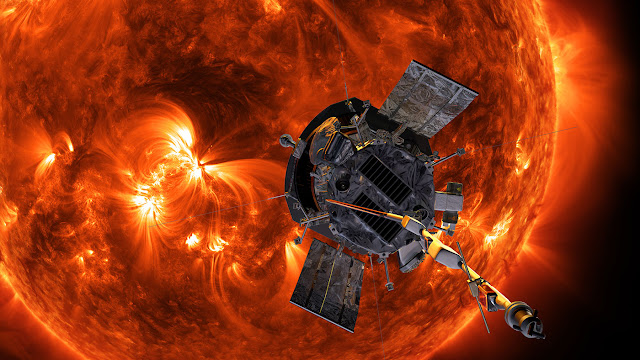How Nasa's solar probe Parker will reach the Sun and will touch it | Why won't it melt
This is really freaking cool to know that Nasa's Parker solar probe is going to touch the Sun and going to study it from a very close distance. This mission is not only about getting to know our Sun but also to know a lot about how other stars work. But the real question is how this probe will be able to travel such a huge distance and how will it be able to fly through million degree plasma and won't melt.
The distance of Earth from Sun is 149.6 million km and in this case Nasa's Parker solar probe will reach as close as 6 million km from sun's surface. Many of you may or may not know that it will become the fastest ever human made object. And it is set to travel around 692000 km/h. On earth that would be like going from Washington D.C. to Tokyo in less than a minute.
But what makes that spacecraft so speedy? Actually it is entirely due to the gravity of Sun. The probe will go so fast because when it will reach so close to Sun it will turn off it's own speed and will use the huge gravity of Sun. Actually the stronger the gravity the stronger the pull on the probe factor will work here that will help the probe to get such mind blowing speed.
Nasa's Parker solar probe was launched on 12 August 2018 and it will take almost 7 years to reach to it's final distance and then it will start scanning the atmosphere of Sun. Though Nasa's deep space journey sun touching mission has started out well but in near future anything can happen. Scientists are continuously watching and monitoring it's movement.
Nasa's Parker solar probe was launched on 12 August 2018 and it will take almost 7 years to reach to it's final distance and then it will start scanning the atmosphere of Sun. Though Nasa's deep space journey sun touching mission has started out well but in near future anything can happen. Scientists are continuously watching and monitoring it's movement.
This solar probe was named after a living person, honoring physicist Eugene Parker who is actually an American solar astrophysicist.
Now in this article we will discuss on how this Parker solar probe will be able to survive in such heat and plasma that come out of the Sun. Actually Parker solar probe and it's instruments will be protected from the sun's heat by a 4 to 5 inch thick carbon-carbon composite heat shield.
The Parker solar probe's journey takes it into the sun's corona, bubble of plasma stretching millions of miles from the sun's surface, to survive in such conditions the spacecraft will carry heat shield made of carbon carbon composite. The sun facing side of the solar probe will reach temperature as high as 2500 degrees fahrenheit when the spacecraft is close to the sun, the SACS will keep the solar array partially exposed to the Sun's direct radiation at less than 302 degrees.
Thank You for reading this article
Thank You for reading this article



Comments
Post a Comment